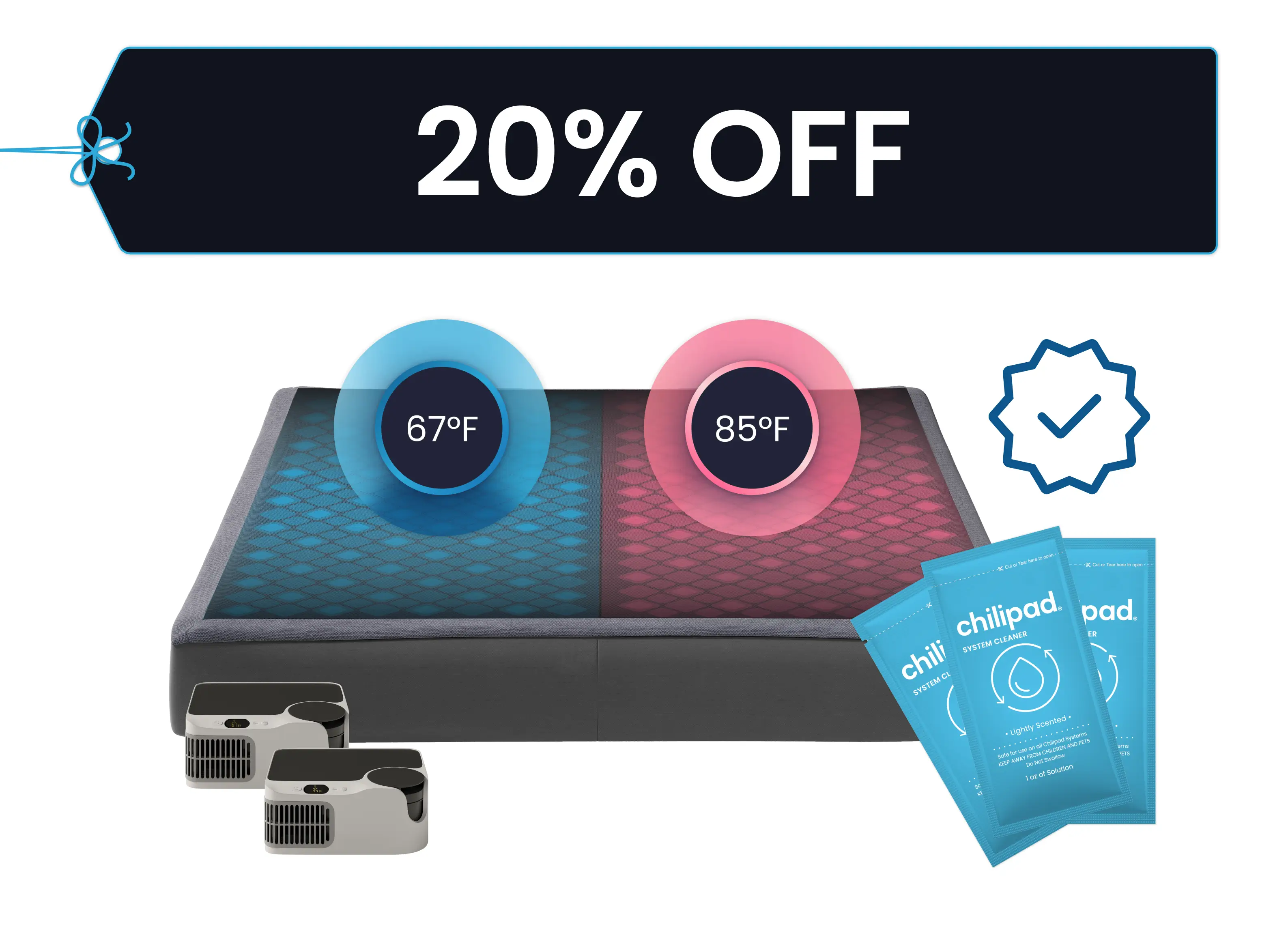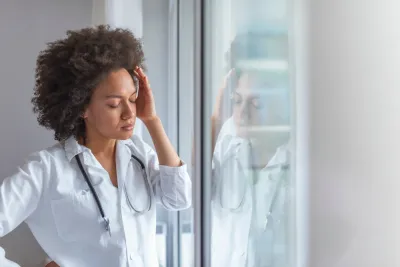Different Types of Sleep Disorders: Causes and Treatments
Chilipad Editorial Team • Feb 09, 2023

Key Takeaways
- Sleep Disorders Overview: Sleep issues like insomnia, sleep apnea, restless legs syndrome, and narcolepsy are more common—and treatable—than you might think.
- Insomnia Insights: Trouble falling or staying asleep? Insomnia could be the culprit, often tied to stress, diet, or lifestyle habits.
- Sleep Apnea Signals: Loud snoring and gasping during sleep might point to sleep apnea—a serious condition that affects breathing and overall health.
- Restless Legs Reality: Uncontrollable urges to move your legs, especially at night, could disrupt your sleep more than you realize.
- Treatment Options Available: From lifestyle tweaks to medical interventions, there are plenty of ways to reclaim your nights and recharge your days.
While everyone looks forward to a great night’s rest, many are only able to daydream about it. For some, a night can seem endless due to tossing and turning from a recognized sleep disorder. In fact, up to 70 million people [1] in the United States alone suffer from chronic long-term sleep disorders.
Whether it’s insomnia, narcolepsy, or sleep-related breathing disorders, the good news is most disorders can be alleviated or cured with the proper diagnosis and treatment.
"When you find depression, even when you find anxiety, when you scratch the surface, 80 to 90 percent of the time you find a sleep problem as well." – Bob Walgrast, University of Delaware, psychologist
Sleep Cooler & Wake Refreshed
Get a cooler, more restful sleep with our bed cooling systems. Fall asleep faster with the Chilipad and wake up feeling refreshed and energized by maintaining the perfect sleeping temperature.
Below, we’ll highlight the more common sleep disorders, how they can affect you and how to treat them.
What Are Sleep Disorders?
Sleep issues (sleep-wake disorders) disrupt the quality, timing, and quantity of sleep a person gets, leading to distress and impairment during the day. These disorders can accompany medical or other mental health issues, particularly depression, anxiety, and cognitive disorders.
Sleep problems can lead to or worsen conditions such as depression and anxiety, emphasizing the importance of identifying and addressing these issues for overall well-being. The most common sleep-wake disorder is insomnia, with other types such as obstructive sleep apnea, parasomnias, narcolepsy, and restless leg syndrome following behind.
The Importance of Sleep
It affects how you heal, how you feel when you're awake, and helps your body and brain function. In children and teenagers, it's important for physical growth, academic performance, and physical and mental health. If you don't get enough sleep, you drastically increases the risk of long-term health problems and sleep disorders.
What Are Common Sleep Disorders?
A large portion of the population struggles with sleep-related issues. With approximately 80 types of sleep disorders, we’ve highlighted the most common ones and included descriptions. Obstructive sleep apnea occurs due to the relaxation of tissues in the mouth and throat, which can block the upper airway.
Insomnia
A physician may conduct a physical exam to rule out other medical conditions that may affect sleep, demonstrating its role in the broader diagnostic process. [2]
While all cases vary, some chronic insomnia is brought on by stress or other psychological pressures. In contrast, other cases could be related to medical conditions such as sleep apnea, or chronic pain.
Did You Know: Sleep disturbances can seriously impair functioning and health.
If you feel as though you’re suffering from insomnia, visit your doctor to discuss your options. Depending on what is causing your insomnia, whether it be psychological or medical, treatments range from:
- Cognitive Therapy
- Medical Therapy
- Alternative Medicines
Symptoms of Insomnia
- Irritability
- Depression
- Weight Gain
- Difficulty Concentrating
- Often interferes with school and work performance
**Did You Know: ** As many as 50% of adults may experience insomnia at some point in their lives.
Narcolepsy
Have you ever felt so tired you could fall asleep right where you are? With narcolepsy, that could very well happen. It’s estimated that the number of people that suffer from narcolepsy in the US is anywhere from 135,000 to 200,000 and almost 3 million suffer worldwide. [3]
Narcoleptics tend to struggle during their day-to-day activities because, due to their symptoms, they could fall asleep at any moment, have the potential to hallucinate as they move between their asleep and awake states, and can suffer from sleep paralysis.
Common symptoms of narcolepsy include daytime sleepiness, change in REM sleep, sudden loss of muscle tone, sleep paralysis, and hallucinations.
If you are unaware, it's a phenomenon where your muscles are relaxed and unable to move, but you’re conscious and aware of your surroundings.
It’s thought that only 25% of cases of narcolepsy are diagnosed, and many people suffer with these symptoms without knowing that there could be help. [4] If you are experiencing any of these issues, you should speak with your doctor.
While narcolepsy cannot be fully cured, some medicinal alternatives and therapies could make a narcoleptic’s day much easier.
Treatments:
- Modern medications
- Lifestyle adjustments
- Support groups
Sleep Apnea
Sleep apnea is dangerous for various reasons. If you suffer from sleep apnea, [5] this means that your breathing is often interrupted throughout the night, which results in an improper flow of oxygen to your brain and the rest of your body. The outcome can be not getting enough sleep.
This can occur in one of two ways - either your throat muscles relax, causing an obstructed airway, or your brain stops sending signals to your body to breathe. Sleep related hypoventilation is another disorder characterized by episodes of shallow breathing and low oxygen levels during sleep.
It can lead to symptoms like excessive daytime sleepiness and insomnia, significantly impacting quality sleep.
Due to the poor airflow circulation throughout your body, you could develop other health-related problems like an irregular heartbeat, depression, diabetes, and more. [6] The good news is there are solutions that can help you breathe throughout the night, like a CPAP machine.
CPAP, meaning “Continuous Positive Airway Pressure,” helps you breathe throughout the night and prevents your airway from collapsing when it normally might.
Other Treatments
- EPAP machine
- Surgery
- Oral Appliances
Types of Sleep Apnea
There are two types of sleep apnea.
Obstructive Sleep Apnea: This occurs when the airway becomes blocked or narrowed, causing a cessation of airflow.
Central Sleep Apnea: There is a disruption in the connection between the brain and the muscles responsible for controlling breathing.

Restless Leg Syndrome
Restless leg syndrome (also known as RLS) is a disorder that causes severe twitching and tingling throughout the muscles in the legs. The only way to alleviate this pain is to move your legs, resulting in sleep disruption. RLS is typically caused by chronic conditions, medications, or pregnancy and can easily lead to sleepiness and daytime fatigue.
IRisk factors for RLS include various health conditions, lifestyle choices, and genetic predispositions. These factors can vary across different conditions, such as sleep apnea and shift work disorder.
It can be frustrating to people with RLS because its symptoms don’t appear until a person is relaxed or lying down, preventing them from falling asleep at night or getting a full night’s rest.
There are a variety of non-medication options for those that suffer from RLS. However, if those options don’t work, it’s best to seek medical advice for additional recommendations.
Did You Know: The prevalence of RLS in the United States is thought to be between 7-10% of the population, with a higher incidence among women than men. Additionally, this sleep disorders, unfortunately, can occur at any age. [7]
As of now, there is no known cure for RLS. However, there are a few steps that a person suffering from RLS can take to help lessen the severity of the symptoms:
- Regular exercise
- Decrease in caffeine or alcohol
- Medication, though medication doesn’t always help
Healthy sleep habits, exercise, medical devices, dietary changes, and medications are effective treatment strategies for RLS. The symptoms aren’t just brought on by rest—they can also be aggravated by caffeine intake and some medications.
Night Terrors
They are defined as episodes of extreme movement, kicking & screaming, and fear while asleep. [8] While they can affect children and adults, they more commonly affect children. Although they are quite literally terrifying in nature, most children will grow out of them by their teenage years.
They typically happen in children due to an over-arousal of the central nervous system during sleep. Nightmares differ from these nighttime terrors because nightmares happen during the REM stage of sleep, while happen during deep, non-REM sleep.
Sleep Terrors vs. Night Terrors
They are literally the same, but they happen in adults. They can be caused by anything from a head injury to stress or medications and even by sleep deprivation.
They differ from nightmares because the sufferer of a nightmare will often awake from the bad dream with a vague memory of the incident. With episodes of intense fear during sleep, an adult is less likely to remember the reason for the terror, just small bits, perhaps.
Additionally, individuals cannot wake up when they suffer from Night Terror. This occurs during non-REM sleep, generally stage 4 of the REM cycle, which makes it extremely difficult to wake up or be woken up during the terror.
Even if you move around, walk around the house or engage in aggressive behavior, it is likely you will not remember it in the morning.
After conducting tests, depending on the root cause of the terrors, the treatment could revolve around the following:
- Improved sleep habits
- Medication
- Counseling
Parasomnias
Parasomnias can occur in a state between sleep and wakefulness. A person may act alertly, such as walking, talking, eating, etc., but without awareness. Another type of parasomnia may cause terrors due to the brain being only partly conscious.
Sleep-related hallucinations are another type of parasomnia that occur either at sleep onset or upon awakening. These hallucinations can resemble vivid dreams or nightmares and are characterized by complex imagery experienced while the individual is clearly awake, distinguishing them from typical dream experiences.
Below are the most common types of actions related to the sleep disorder, parasomnia:
- Sleepwalking
- Groaning
- Sleep-related Eating Disorders
- Sleep Talking
- Teeth grinding or Jaw clenching
Circadian Rhythm Disorders
Circadian rhythm disorders occur when your body’s internal clock—the system that tells you when to sleep and wake—is out of sync with your environment. This sleep disorder can lead to trouble falling asleep, waking up too early or too late, and feeling tired at odd hours. Common causes include shift work, jet lag, or even just poor sleep habits.
Circadian rhythms play an essential role in regulating the sleep-wake cycle, and misalignment with these natural rhythms can lead to disorders such as non-24-hour sleep wake disorder and shift work disorder.
Left unchecked, these disruptions can impact your mood, energy, and overall health.
When to See Your Doctor
As you can see, there are many sleep disorders that affect so many individuals. Suppose you or anyone you know is afflicted with any of the above sleep disorders, having a hard time falling asleep, and you/they have been unable to get relief without medical assistance. In that case, it might be time to reach out to a doctor, a family physician, or a professional.
A sleep study, or polysomnography, can help sleep disorders diagnosed. They are clinical test that monitors sleep patterns and identifies specific sleep problems, essential for determining the correct diagnosis and options for treatment.
Final Thoughts
While there are a variety of sleep disorders, there are solutions and steps that will allow you to take back a good night’s sleep and improve your deep sleep. Whether it’s medical treatment or lifestyle changes, both can greatly improve your sleep quality.
Frequently asked questions
How Can I Tell If I Have a Sleep Disorder?
If you constantly wake up exhausted, snore loudly, feel the urge to move your legs at night, or doze off during the day without meaning to, your body could be waving a big “help me sleep better” flag.
Trouble sleeping can be a common symptom of various sleep disorders, emphasizing the importance of recognizing these symptoms for proper diagnosis.
Can Sleep Disorders Affect My Health?
Absolutely. Poor sleep can lead to weight gain, heart disease, diabetes, depression, weakened immunity, and a cranky, less-focused version of yourself. Treating sleep disorders early is key to staying healthy and sharp.
What Are the Treatment Options for Common Sleep Disorders?
Treatment varies but often includes:
- Cognitive Behavioral Therapy (CBT): Especially for insomnia.
- Continuous Positive Airway Pressure (CPAP) Therapy: For sleep apnea.
- Medication: When necessary, under a doctor’s care.
- Lifestyle Changes: Think better sleep hygiene, exercise, and stress reduction.
- Medical Devices: Like oral appliances for snoring or apnea.
How Many Types of Sleeping Disorders Are There?
There are over 80 distinct types of sleep disorders, but most fall into broad categories like insomnia, sleep apnea, restless legs syndrome, narcolepsy, circadian rhythm disorders, and parasomnias (like sleepwalking).
Each one disrupts your sleep in its own quirky way—whether it’s keeping you from falling asleep or turning your dreams into a full-blown action sequence.
Ask ChatGPT
References
[1] SingleCare Team. (2021, March 25). How much sleep does the average American get? View Resource
[2] Mayo Clinic. (2016, October 15). Insomnia - Symptoms and causes. View Resource
[3] Narcolepsy Fact Sheet | National Institute of Neurological Disorders and Stroke. (2022, September 27). View Resource
[4] Mitler, M. M., Hajdukovic, R., Erman, M., & Koziol, J. A. (1990). Narcolepsy. Journal of clinical neurophysiology : official publication of the American Electroencephalographic Society, 7(1), 93–118. View Study
[5] Mayo Clinic. (2020, July 28). View Resource
[6] Alexandra Benisek. (2021, September 7). Sleep Apnea Basics. View Resource
[7] RLS Fact Sheet | National Institute of Neurological Disorders and Stroke. (n.d.). View Resource
[8] Sleep terrors - Symptoms and causes. (2018). View Resource









